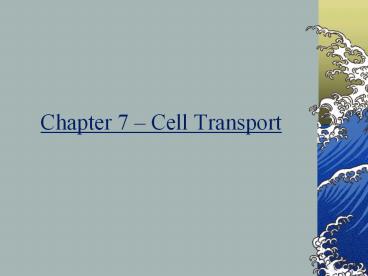Chapter 7 - PowerPoint PPT Presentation
1 / 36
Title:
Chapter 7
Description:
Chapter 7 Cell Transport I. Cell (Plasma) Membrane Recall from Chapter 7 that the cell membrane is composed of lipids (because they can separate substances.) – PowerPoint PPT presentation
Number of Views:98
Avg rating:3.0/5.0
Title: Chapter 7
1
Chapter 7 Cell Transport
2
I. Cell (Plasma) Membrane
- Recall from Chapter 7 that the cell membrane is
composed of lipids (because they can separate
substances.)
3
Cell Membrane (contd)
- The membrane is made of many phospholipids which
have two parts hydrophilic (water loving) heads
and hydrophobic (water fearing) tails.
4
Cell Membrane (contd)
- Notice also that the membrane is made of two
layers of lipids called a lipid bilayer.
5
Cell Membrane (contd)
- Also found in the cell membrane are certain
proteins, which play an important part in the
cell by - 1) Coordinating cell-to-cell behaviors.
- 2) Adjusting the cells metabolism rates.
- 3) Initiating growth division times.
6
Summary of Cell Membrane Structure
- Membrane is semi permeable
- Membrane is composed of a lipid bilayer (2 layers
of lipids and phosphates) - Membrane has many different types of proteins
embedded into it - These 2 things together make the fluid mosaic
model
7
Cell Membrane (contd)
8
A. Marker Proteins
- Helps cells recognize similar cells.
- This is helpful for when our defensive cells
encounter bacteria with unknown marker proteins,
they can then destroy them.
9
B. Receptor Proteins
- Helps cells receive materials/signals outside of
the cell. - When cells need stored energy from the pancreas,
they release signal molecules, which find and
bind with the pancreas cells to let them know to
release some energy.
10
C. Channel/Carrier Proteins
- Helps substances move across the cell membrane.
- If substances are too large to get through the
lipid bilayer channel proteins (doughnut shaped)
act as passage ways.
11
II. How Substances Move
- There are 2 types of transport across cell
membranes - Passive transport that does not need any
energy. - Active transport that requires energy.
12
(No Transcript)
13
Passive Transport
- Passive transport (no energy required) can occur
in 4 different ways - i) Simple Diffusion
- ii) Osmosis
- iii) Diffusion through Ion Channels
- iv) Facilitated Diffusion (Carrier Proteins)
14
Passive Transport (contd)
- During passive transport substances always move
from high concentration to low concentration
(this is known as a concentration gradient). - After passive transport when the concentration of
molecules is the same we say equilibrium exists.
15
i) Diffusion
- Diffusion is the movement of molecules down a
concentration gradient, from high to low
concentrations. - Examples food coloring in water, perfume
spreading throughout a room, etc.
16
(No Transcript)
17
ii) Osmosis
- Osmosis is the diffusion of water across a
semipermeable (cell) membrane. - It is the same process as diffusion except it
specifically means water movement.
18
(No Transcript)
19
a) Solutions
- A solution is a mixture of solutes (things being
dissolved) and a solvent (things doing the
dissolving). - Water is typically the solvent. (i.e. sugar cube
in water, the sugar is the solute)
20
b) Types of Solutions
- 1. Hypertonic solution with a higher
concentration of dissolved particles than its
surroundings. - 2. Hypotonic solution with a lower concentration
of dissolved particles than its surroundings. - 3. Isotonic solution with an equal concentration
of dissolved particles to its surroundings.
21
c) Water Balance in a Cell
- 1. Cells placed in a hypertonic environment (salt
water) will plasmolysis. SHRINK!
22
c) Water Balance in a Cell
- 2. Cells placed in a hypotonic environment (fresh
water) will cytolysis. BURST!
23
c) Water Balance in a Cell
- 3. Cells placed in a isotonic environment will be
balanced.
24
(No Transcript)
25
Water Movement Problems
26
iii) Diffusion through Ion Channels
- An ion channel is a doughnut shaped channel
protein that is hydrophilic (polar) inside. - Ions can pass through the channels without
contacting the hydrophobic (nonpolar) part of the
cell membrane.
27
Ion Channel (B)
28
iv) Facilitated Diffusion
- Facilitated diffusion is a passive form of
transport caused by carrier proteins specific for
the molecules they transport. - Remember movement is always down the
concentration gradient. (i.e. high to low) - Also facilitated diffusion needs no energy.
29
a) Steps in Facilitated Diffusion
- 1. A molecule outside the cell binds to the
carrier protein. - 2. The carrier protein transports the molecule
across the cell membrane. - 3. The molecules are released inside the cell.
30
31
B) Active Transport
- There are many types of active transport, but the
2 we will learn are - i) The Sodium-Potassium (Na-K) Pump
- ii) Movement by Vesicles
32
Active Transport (contd)
- Active transport is the movement of molecules up
(against) the concentration gradient, from low to
high. - Remember this time the cell must use its own
energy (ATP) to move substances.
33
i) Sodium Potassium Pump
- It takes 3 sodium ions out for every 2 potassium
ions put in the cell. - There is more sodium inside the cell and more
potassium outside the cell so the cell is working
against the concentration gradient. - Energy for the pump comes from ATP made by the
mitochondria.
34
(No Transcript)
35
ii) Movement by Vesicles
- There are 2 types of vesicles
- Endocytosis into the cell.
- Exocytosis out of the cell.
36
Any Questions?
- Knowledge is not simply another commodity. On
the contrary. Knowledge is never used up. It
increases by diffusion and grows by dispersion.
- --Daniel J. Boorstin































